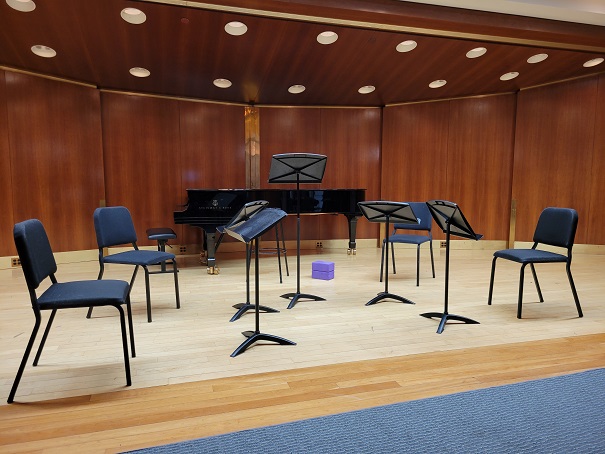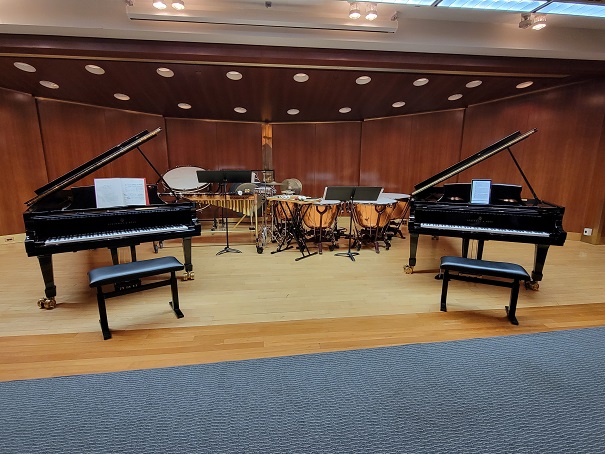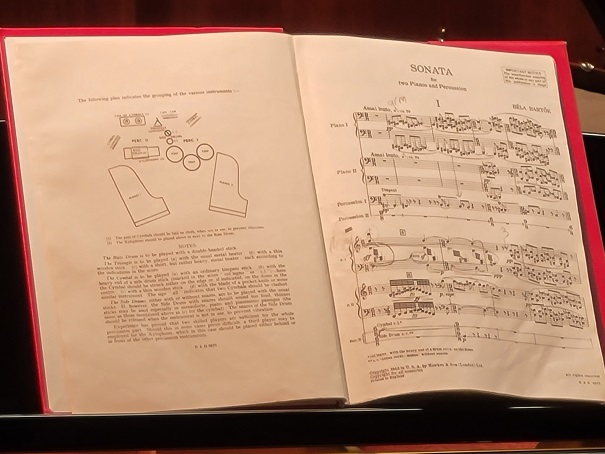Concert Diary: Chamber Music Marathon at Juilliard
December 19, 2021
New York, N.Y.
How much live chamber music can a person experience in a single day? When I saw that the Juilliard Performance Calendar listed five free recitals of chamber music on Sunday, December 13, 2021, I decided to find out.
The concerts were spread throughout the day, and they all took place in Morse Hall. (Go up the stairs at the main Juilliard entrance, past security, turn left to the elevators and go down one floor to the ST level.) This is a nice intimate space. The musicians are on the same surface as the audience, and a low ceiling over the performers seems to facilitate a loud vibrant sound:
The seats, however, are molded plastic — not the padded seats available to the musicians — and while they were fine for much of the day, by the end of the evening I was sore and trying hard not to squirm.
The recitals ranged in length from 90 minutes to two hours. I saw performances of 16 compositions (although 19 were originally scheduled) by 11 different composers performed by over 50 student musicians, divided about equally between men and women.
The intimacy of the space inhibited my photographing the musicians even when they were not performing. (Also, the program contained a note that photography was prohibited.) Some used tablets with Bluetooth foot pedals for the music while others used traditional scores. Most were dressed in black and everyone was masked except for the wind players, and even one of them had what appeared to be a special mask with a flap large enough to fit her clarinet mouthpiece.
Chamber Music Recital #1 at 10:30 AM
The day of music began with Sergei Prokofiev’s Quintet in G minor (Op. 39), which was composed in 1924 in Paris using music he had written for a ballet troupe whose ensemble consisted of just oboe, clarinet, violin, viola, and double bass. Hence the quirky instrumentation. And because it’s 1920s Paris, hence the quirky music with its off-kilter harmonies and jagged rhythms, and trips into crazy town. I found it all quite sensually captivating.
Following the Prokofiev was the middle of Beethoven’s five cello sonatas, the Cello Sonata No. 3 in A Major (Op. 69) with its lovely opening cello melody, a haunting development section, a thoroughly quirky Scherzo, followed by an enticing Adagio Cantabile that turns out to be just a short introduction to the joyful and foot-tapping Allegro finale.
And then, a favorite of nearly everyone: Maurice Ravel’s String Quartet in F Major, with its lyrical first movement, the famous pizzicato passages of the second movement, the beautiful and eerie third movement, and the aggressive finale.
The day is off to a great start.
Chamber Music Recital #2 at 1:00 PM
About a half hour to an hour separated the recitals during the day, but I felt it was too short to go to a proper restaurant, and fast food is scarce in the Lincoln Center neighborhood. Fortunately, on the other side of the block (right across from the Juilliard Store) is a Gourmet Garage, and I was able to grab sandwiches during the day and eat inside at a little counter. I also managed a trip up a few blocks to Shakespeare & Co.
This recital began with Mozart’s Piano Quartet in E-flat Major (K. 493), the second of only two piano quartets he wrote. The two outer movements were jolly enough but I most enjoyed the long central Larghetto, which grew on me more as it progressed.
Next up with Schubert’s famous Piano Quintet in A Major (D. 667) nicknamed the “Trout,” but not for the rippling river waves of the piano in the first movement evoking trout jumping through the currents; nor for the long melodic lines of the Andante suggesting the pleasure of eating a butterflied trout dinner; nor for the vigorous Scherzo suggesting a trout pulling at the hook, and the gently contrasting Trio as the trout succumbs to its fate; nor for more trout splashing about in the finale. No, all these trout allusions are imaginary. The work gets its nickname because the fourth movement theme and variations are based on Schubert’s song “Die Forelle.” Regardless, it’s a Schubert favorite.
This recital ended with a piece I was unfamiliar with, Carl Nielsen’s Wind Quintet (Op. 43). Chamber music is often cited as conversational, but never did I get more of a sense of that than in Nielsen’s first movement, which seemed to portray an actual conversation, and quite a lively one at that. I also became quite engaged by the finale Theme and Variations, which began with the instruments in a chorale-like unison. The series of variations each highlighted a different instrument or combinations, and I started to anticipated what would come next. I see in my notes that I counted 12 variations. Apparently there are only 11, but when the chorale came again, I knew it had reached a satisfying conclusion.
Chamber Music Recital #3 at 3:30 PM
I sometimes felt a little sleepy during the day, but never did I fall asleep during the music and let my pen and paper slide from my hand onto the floor. No, no, not that! Often before drifting off to sleep, I start to dream while I’m still awake, but today those pre-sleep dreams were music related, so they added a little flavor to the concert, a little surrealistic mental escapade rather than a distraction. Before those dreams got too weird, I would snap fully awake and couldn’t remember anything about them.
The third recital of the day began with Mozart’s Duet for Violin and Viola (K. 423), which I don’t think I’d ever heard before but which I loved to watch and hear. The two instruments are just a half octave apart, and Mozart weaves some fascinating interlocking melodies that create a very pleasant and enjoyable raport between the musicians. The second movement Adagio is one of Mozart’s slow treasures.
Bartok composed his Contrasts for Violin, Clarinet, and Piano in 1938 for Benny Goodman, and perhaps I hear a frenetic jazzy influsion in the last movement, but the influence is more Hungarian. Each of the movements is named for a Hungarian dance form. The angular melodies of the Recruiting Dance are interrupted by explosive clarinet solos. Following the slow central Relaxation movement is a Fast Dance that starts like a hoedown and doesn’t let up.
Next up was the Beethoven String Quartet No. 3 in D Major (Op. 18, No. 3), so full of strange episodes, with its warm opening and starp chords, a chorale-like Andante that gets more compelling as it goes on, a third movement Scherzo with a more agitated Trio, and a rollicking Presto finale concluding with one of Beethoven’s biggest fake-outs: a totally unexpected quiet ending.
Concluding this recital was Gabriel Faure’s Piano Quartet No. 1 in C Minor (Op. 15) from 1879 and 1883. This work sounded more German and Brahmsian than French to my ears, with its dense and passionate first movement, a jolly Scherzo, quite enticing melodies in the Adagio, and a galloping final Allegro that continued to reveal much lyricism until a life-affirming conclusion.
Chamber Music Recital #4 at 6:00 PM
Live chamber music provides one of the best ways to hear music because it also allows clearly seeing the music. All the musicians are visible and there aren’t that many of them, so we differentiate the individual sounds better and can also observe the various techniques for obtaining the multitude of sounds available from string instruments. I also like to watch the performers’ eyes as they glance at their neighbors to keep together.
Mozart is known more for his string quintets rather than string quartets, but it was fun to hear his String Quartet No. 19 in C Major (K. 465), the last of the quartets he dedicated to Joseph Haydn. This one is nicknamed the “Dissonance” for its intense rising pathos of the opening. The Andante Cantabile that follows is gently swaying, followed by a rambunctious Minuet constrasted with a wonderful minor Key Trio, and a tempestuous second theme in the Finale really shook up the movement.
I was about to say that the recital then went “back in time” for a Haydn string quartet, but that’s not true. Mozart’s string quartet dates from 1785, while the Haydn quartet we next heard is commonly numbered as his String Quartet No. 39 in F-Sharp Minor (Op. 50, No. 4) and dates from 1787. The opening Allegro Spiritoso incorporates a di-di-di-dah motif, and the second movement Andante has a second theme that’s just wonderful, followed by a fugue in the Finale that starts in the cello and moves up through the instruments.
This recital concluded with Beethoven’s middle period Piano Trio in E-flat Minor (Op. 70, No. 2), which is definitely not as famous as Op. 70 No. 1 (nicknamed the “Ghost") but has its own delights and surprises, including a lovely 6/8 first movement, an Allegretto mixes up two contrasting themes, and then (oddly) another Allegretto with a long melody that makes us forget the first Allegretto, followed by a galloping Finale.
Chamber Music Recital #5 at 8:30 PM
When we came in for the final concert, the stage looked much different:
This is the setup for Bartok’s 1937 masterpiece Sonata for Two Pianos and Percussion. The setup with the piano keyboards facing the audience is as Bartok requested, as you can see by zooming in on the score perched on the piano on the left:
For sheer rhythmic and noise-making exhuberance, nothing comes close. And let me tell you: There is nothing quite like college students playing Bartok. They bring an extra energy and enthusiasm that is quite a treat.
It only took about three minutes to clear all the percussion off the stage for a piece I was unfamiliar with: Hungarian composer Erno Dohnanyi’s 1902 Serenade in C Major for string trio, in which familiar forms (march, romance, scherzo) are given unusual treatments, followed by a theme and variations that veers from the romantic to the crazy to the quite heavenly, and a very fast intricate rondo that incorporates folk song elements.
The concert and day concluded with one of my favorites: Brahms’ PIano Trio No. 1 in B Major (opus 8). Nothing quite touches the sheer beauty of the opening movement, a Scherzo whose Trio section makes us forget everything that preceded it, a most heavenly Adagio, and a Finale that just can’t avoid those beautiful melodies.
A little punchy at the end with a sore behind, I nevertheless survived, and felt fully enriched by this long day of chamber music.


